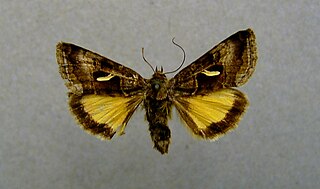
Syngrapha hochenwarthi is a moth of the family Noctuidae. It is found in the Alps, the mountainous areas of Northern Norway and Finland, the Ural mountains, the Balkan, the Caucasus and the Altai mountains.
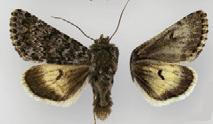
Lasionycta leucocycla is a moth of the family Noctuidae. It can be found in Scandinavia, Siberia and northern North America.
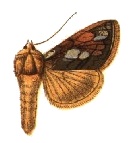
Plusia putnami, the Lempke's gold spot or Putnam's looper moth, is a species of moth of the family Noctuidae. It is found in the Palearctic realm, from Japan and eastern Siberia to Fennoscandia, Great Britain, and France. In North America, it ranges from Newfoundland and Labrador to central Alaska and the interior of British Columbia, south to Pennsylvania, Washington, north-eastern California, and in the Rocky Mountains to Utah and Colorado.

Panthea judyae is a moth of the family Noctuidae. It has been collected in the Mogollon Mountains and Big Burro Mountains of south-western New Mexico, the Huachuca Mountains of south-eastern Arizona, and the Sierra Madre Occidental of northern Mexico, at elevations of 1800–2400 m.

Raphia frater, the brother, is a moth of the family Noctuidae. It is found from Nova Scotia west, across the forested regions of Canada to British Columbia, south to Mississippi in the east. The southern limits in the west are uncertain due to confusion with several closely related species or forms.
The fawn brown dart is a moth of the family Noctuidae. It is found in southern Canada and the northern United States from southern Quebec and eastern Massachusetts west to British Columbia and southern Washington. In the Rocky Mountain region it occurs as far south as northern New Mexico, north-eastern Arizona and central Idaho. It is listed as a species of special concern in Connecticut.
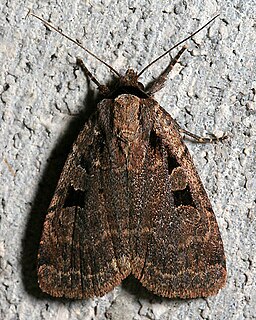
The Two-Spot Dart is a moth of the family Noctuidae. It is found from coast to coast across central and southern Canada, and in the northern United States, south along the Appalachians to western North Carolina and Tennessee. There are a few scattered records along the Rocky Mountains from south-western Montana to south-eastern Arizona.
Lycophotia phyllophora, the lycophotia moth, is a moth of the family Noctuidae. It is found across southern and central Canada from New Brunswick and Nova Scotia to western Ontario, and in the northern United States from Maine to Minnesota, south to Ohio, and along the Appalachians to western North Carolina.
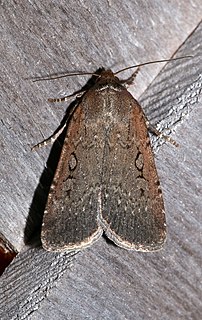
The clandestine dart or w-marked cutworm is a moth of the family Noctuidae. It is found from coast to coast across Canada to southern Alaska, and in the eastern United States from Maine to western North Carolina, west to northern Ohio to North Dakota, South Dakota, Nebraska, and down the Rocky Mountains from Montana to southern Arizona.

Euxoa adumbrata, the sordid dart, is a moth of the family Noctuidae. The species was first described by Eduard Friedrich Eversmann in 1842. In North America it is found across northern Canada from Quebec to western Alaska, south to the northern parts of the United States, and in the mountains to Colorado. It is also found in Greenland, the coastal areas of Scandinavia and the Ural. It was recently recorded from Denmark, although this includes Euxoa lidia, which some authors regard to be a valid species.

Lasionycta uniformis is a moth of the family Noctuidae. It is widely distributed in the mountains of western North America. It occurs from southern Yukon to northern California and Colorado, with an isolated population in eastern Quebec.
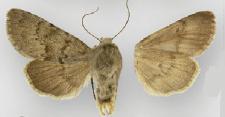
Lasionycta promulsa is a moth of the family Noctuidae. It occurs from Rampart House in northern Yukon to south-western British Columbia in the west and southern New Mexico in the Rocky Mountains.

Blepharita amica is a moth of the family Noctuidae. It is found from northern Europe to the Russian plain, the Ural, Siberia, the Amur Oblast, Primorye Region and Kazakhstan. It has also been recorded from the Korean Peninsula, Japan and north-eastern China.
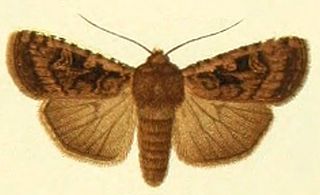
Euxoa ochrogaster, the red-backed cutworm, is a moth of the family Noctuidae. It is found from Iceland and northern Europe, through the Baltic to the Amur region. In North America, it is found from Alaska to Newfoundland and Labrador, south into the northern part of the United States, south in Rocky Mountains to Arizona and New Mexico.
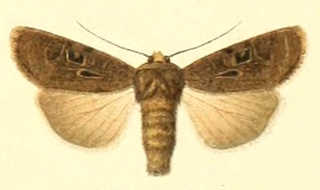
Chersotis andereggii is a moth of the family Noctuidae.

Hadena filograna is a species of moth of the family Noctuidae. Subspecies filograna is found from central and southern Europe to Anatolia. The most northern part of the range is Sweden. Subspecies conspargata is found in Ukraine and from southern Russia to the Altai mountains and ssp. rungsi is found in North Africa.
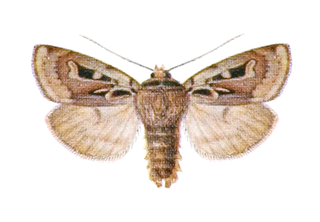
Xestia wockei is a moth of the family Noctuidae. It is known from Siberia and northern North America, including Quebec, Newfoundland and Labrador, the Northwest Territories and Yukon.
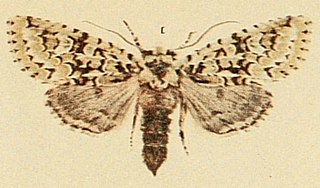
Griposia aprilina, the merveille du jour, is a moth of the family Noctuidae. The species was first described by Carl Linnaeus in his 1758 10th edition of Systema Naturae. It ranges from Sardinia and south-east Russia from the southernmost part of Norway and Saint Petersburg through northern and central Europe to southern France and northern Italy, as well as in Castile. Also in western and central Anatolia and the Caucasus. Also in Asia minor. There is recent evidence from the Alborz mountain range.

Mythimna anderreggii is a moth in the family Noctuidae. It is found in the mountains of Europe. It is also present in the northern Caucasus, the Gissar Range, the Pamir mountains and the Tian Shan mountains.

Xestia tecta is a moth of the family Noctuidae. In Europe the species is only known from the boreal area of Fennoscandia, north-western Russia and the northern Ural Mountains. Outside Europe it occurs in northern and central Siberia and the north-western USA including Alaska as well as north-western and central Canada.













